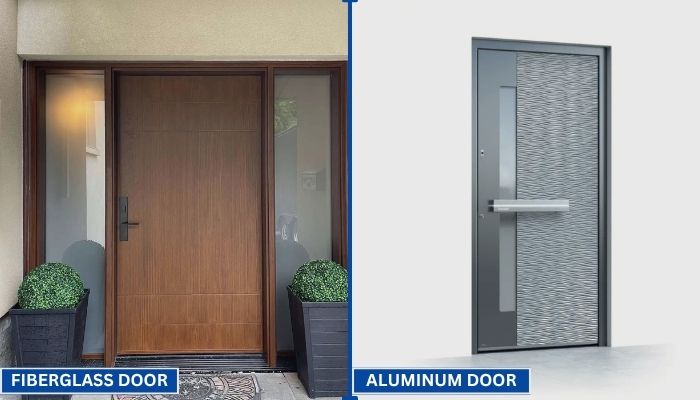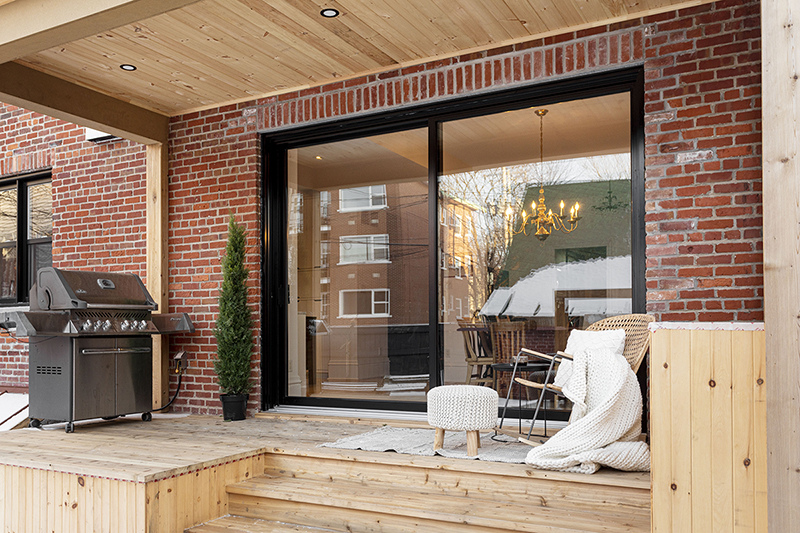Aluminum vs Fiberglass Doors: Which One Should You Choose?

Your front door does more than just open and close. It protects your home, adds curb appeal, and helps control indoor temperature. That’s why picking the right door material matters.
Two popular choices today are aluminum and fiberglass. Both are strong, stylish, and made to last. But they serve different needs.
In this guide, we’ll walk you through what each door is made of, how they perform, and which one may be the better fit for your home.
What Is a Aluminum & Fiberglass Door
Aluminum Door

An aluminum door has a metal shell over an insulated core. It’s light but strong. It won’t rust like steel, and it works well in humid or rainy areas.
Aluminum doors are common in modern homes. They have a clean, sleek look. They are often used for side doors, garage entries, or utility spaces.
While not as warm-looking as fiberglass, aluminum offers solid performance with a more industrial feel.
Fiberglass Door

A fiberglass door is made from tough, molded fiberglass panels. Inside, it usually has a solid foam core. This helps with both strength and insulation.
The outer layer can be smooth or textured. Some even look like real wood. They’re designed to handle harsh weather, heavy use, and long-term wear.
Fiberglass doors are often chosen for their low maintenance and energy-saving features. They’re a top choice for homes in cold or changing climates.
Aluminum vs Fiberglass Doors: Comparison On Different Side
Durability and Weather Resistance
Fiberglass doors are built to last. They don’t rot, rust, or swell. Rain, snow, or sun — they handle it all. That makes them a great choice for Toronto’s changing seasons.
Aluminum doors don’t rust either. They do well in humid or coastal areas. But they can dent more easily than fiberglass. And in extreme cold, the surface can feel very cold to the touch.
If you want a door that stays solid year after year with little worry, fiberglass is the safer pick.
Insulation and Energy Efficiency
Fiberglass doors have excellent insulation. The foam core inside helps keep your home warm in winter and cool in summer. You’ll feel the difference, especially near the entry.
Aluminum doors have an insulated core too, but the outer metal shell can transfer heat or cold more easily. That means they don’t insulate as well as fiberglass, especially in colder climates.
If energy savings and indoor comfort are important to you, fiberglass gives you better performance.
Style and Appearance
Fiberglass doors come in many styles. You can choose smooth or wood-grain finishes. Some even look like real oak or mahogany. They can be painted or stained to match your home.
Aluminum doors have a modern, clean look. They’re often used in homes with sleek, minimal design. You can get them in bold colors or metallic finishes, but they don’t have the same warmth or texture as fiberglass.
If you want classic charm or wood-like style, fiberglass is the way to go. If you prefer a bold, modern look, aluminum may suit you better.
Maintenance Requirements
Fiberglass doors are very low maintenance. They don’t chip, peel, or rust. A quick wipe with soap and water is usually enough to keep them looking new. You may need to repaint or re-stain them after several years, but only for appearance.
Aluminum doors are also easy to care for. They don’t rust, and the finish lasts a long time. But they can dent more easily. If that happens, the dent usually stays unless repaired or replaced.
If you want something that looks good with little work, both options are solid. Fiberglass needs less repair over time, especially in high-traffic areas.
Security and Structural Performance
Both fiberglass and aluminum can be secure. What matters most is how the door is installed. A strong frame, solid lock, and good fit are key.
Fiberglass doors are thick and hard to damage. They hold up well against force. The material doesn’t bend or crack easily.
Aluminum doors are strong too, but they are lighter and may flex under pressure. If you’re focused on a heavy, solid feel, fiberglass has the edge.
Still, the real protection comes from the full setup: door, frame, lock, and hinges all working together.
Cost Comparison
Fiberglass doors usually cost more upfront than aluminum, but they give better insulation and longer lifespan. You save more on energy bills and repairs over time.
Aluminum doors are more affordable at the start. They’re a good option for tight budgets or side doors. But they may cost more in the long run if you need to fix dents or deal with cold spots.
If you want the best value over time, fiberglass is worth the investment. If you need a simple, cost-effective option now, aluminum can work well too.
| Feature | Fiberglass | Aluminum |
|---|---|---|
| Durability | Rot-proof, dent-resistant | Rust-resistant, but can dent/crack |
| Insulation | Excellent | Lower; metal thermally conductive |
| Maintenance | Clean with soap | Low-maintenance; may need occasional touch-up |
| Aesthetics | Wood-look finishes available | Industrial; fewer style options |
| Coastal Use | Excellent | Good, better than steel |
| Security | Solid when installed correctly | Functional, frame matters more |
When to Choose Which
Both fiberglass and aluminum doors have their strengths. The right choice depends on your home, your needs, and your budget. Here's a simple way to decide.
Choose Fiberglass if:
- You want strong insulation for better indoor comfort
- You prefer a door that looks like real wood
- You live in a cold or mixed climate
- You want a heavy, solid-feeling door
- You’re looking for something that lasts with little upkeep
Choose Aluminum if:
- You like a modern, sleek look
- You live in a humid or coastal area
- You want a door that resists rust and corrosion
- You need a lighter door for side or back entry
- You’re working with a smaller budget
Each door has a place. Fiberglass is the all-rounder. Aluminum is a good fit for utility and modern use. At the end of the day, it comes down to what matters most to you.











